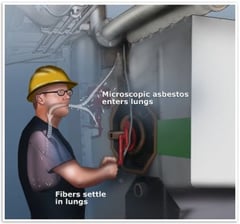Renovating your home? Avoid exposure to these hazardous chemicals
[This is a guest post by Brian Turner, a toxic substance safety advocate.]
Do-it-yourselfers get a thrill out of learning how to tackle new projects that both raise their property value and confidence. Best of all, the amount of money that can be saved on labor is often significant. However, it is important during home renovations of any kind to be aware of potential health hazards. If the homeowner’s health is compromised, the money saved was in vain.
Asbestos: Common Danger

Asbestos is a mineral fiber that was commonly used to make building material prior to 1978. At that time, it was discovered that the tiny fibers that make up asbestos were capable of breaking up into the air. When inhaled, they become attached to the lungs and can remain there for years. SERS Environmental Monitoring Australia can check your building for asbestos and make sure it is safe to be there.
Those who are exposed to asbestos face a variety of possible illnesses. From mesothelioma to lung cancer, inhalation can even lead to death. Unfortunately, since the effects of asbestos were unknown until the late 70’s, many buildings still contain this toxic material.
When completing home renovations, do-it-yourselfers should understand that only scientific analysis can determine whether or not a substance contains asbestos. Although it is difficult to identify, there are some indicating factors to keep on the lookout for. In regards to the asbestos removal process, this article is fantastic.
Woven Material
The fibers that make asbestos can be woven into a cloth, and this form can commonly be found in door linings and floor tiles.
Crumbling
Asbestos is often found to be peeling, crumbling or otherwise falling apart. If this type of material is observed, it should be tested immediately.
Color
Depending on its form, asbestos comes in a variety of colors. However, key colors to be on the lookout for include white, brown, silver, lavender, yellow and blue. Asbestos is commonly a problem for those in both the mining and automotive industries. More information regarding those particularly at risk for asbestos-related illness can be found provided by the Environmental Protection Agency.
In the Closet Problem
Dry-cleaning provides a great way to preserve quality clothing; however, few realize that the solvent chemically known as perchloroethylene is used during the dry cleaning process. As the clothes sit in the closet, this chemical can build up, posing potential threats to the respiratory system. Before spending time renovating a closet area, ensure all clothes that have recently been dry-cleaned have been allowed to air out prior to being placed in the closet.
Lead-Based Paint
Similar to asbestos, the dangers of lead-based paint were not recognized until long after they had gone on the market. As a result, these paints are still around us posing dangers that can lead to headaches, irritability, chest pains and even death. Any resident battling daily exposure to lead-based paint should clean toys and other items often. Furthermore, peeling paint should be removed immediately. To completely eliminate the problem, the EPA’s renovation, repair, and painting program is a good place to start.
[Brian Turner has been working with the Mesothelioma Cancer Alliance as an environmental health and toxic substance safety advocate since June of 2007. Brian brings a tremendous amount of research and awareness experience in environmental health risks, environmental carcinogens, and green building expertise.]

